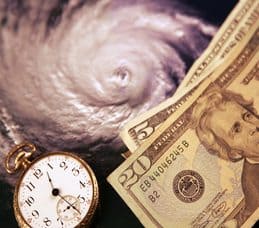
They were originally introduced in the mid 1990s during the aftermath of hurricane Andrew and the Northridge earthquake. When it became apparent the current system of re-investing insurance premiums would struggle to cope if a number of natural disasters, such as a major earthquake and hurricane occurred at the same time. The resulting financial pressure would force many insurance companies to default, leaving homes and vital infrastructure uninsured.
How Do Catastrophe Bonds Work?
Catastrophe bonds work like this: The bond issuer, in this case a reinsurance company, agrees to pay you, the bond holder, a monthly coupon in return for your bond capital. This capital is then invested in low risk securities. You will receive this coupon, until such time as the catastrophe bond is triggered. If the bond is triggered the coupon is suspended and the returns are diverted by the issuer to settle policyholder claims.
That’s all very well, but there are many different types of natural disaster, and the likelihood of them happening varies dramatically. For instance, it’s much more likely an earthquake will strike southern California than an asteroid hit Manhattan. So how do you know what risk you’re undertaking?
When catastrophe bonds are issued they’re assigned a trigger type and a risk rating. So lets say your catastrophe bond is to cover the risk of a tornado in Nebraska. Since Nebraska sits in the middle of Tornado alley, the risk of damage to property by tornado is quite high, so your catastrophe bond’s risk rating will reflect this. Therefore your initial coupon will be set high to reflect the extra risk you’re undertaking, but the likelihood of your bond being triggered is greatly increased.
So imagine you’re watching CNN and you hear a tornado has struck Nebraska, destroying property and crops. Your second thought, after after thinking about the people involved, will be. Has my catastrophe bond been triggered?
The answer to this will depend on your particular bonds trigger type.
There are four trigger types for catastrophe bonds: Indemnity trigger, Modeled loss, Indexed to industry loss and Parametric.
Lets take a closer look at each of these in detail.
1. Indemnity
The indemnity is the amount which has to be paid by the issuer. Using the indemnity model the bond will be triggered when losses meet the agreed upon amount. Let’s say your bond has an indemnity of $100 million with an excess of $500 million. In this case, once the losses amount to more than $500 million, $100 million has to be paid and the bond is triggered.
2. Modeled Loss
The modeled loss is a variation of the indemnity loss, but this time the losses are predetermined using software that simulates the specific catastrophe. When a catastrophic event takes place, the losses of the actual event are compared to those simulated by the software. Once the losses pass a specific threshold, determined by the software, the bond is triggered.
3. Indexed to Industry Loss
This type of bond is triggered when the loss to the insurance industry as a whole, passes a predetermined threshold. Lets say the threshold is set at $20 billion for an earthquake in California. Once the overall losses from the event breach that amount, the bond will be triggered. The bond will specify who determines the industry loss; typically it’s a recognized agency and not the issuer of the bond.
4. Parametric
This model is easier to understand, because the bond is triggered not by the losses which are sustained, but by the parameters of the event itself. Lets say your catastrophe bond is to insure against the losses caused by a hurricane in Florida. In which case the parameters of the hurricane are set in the bond. For a hurricane that parameter would be wind speed. Your bond will stipulate the actual wind speed which has to be attained before the bond is triggered.
Are Catastrophe Bonds Right For You?
Catastrophe bonds carry a large amount of risk, they’re usually rated BB and lower by the ratings agencies, which puts them in the same category as Junk Bonds. The potential rewards are there to see however, catastrophe bonds have been yielding an average of 9.4% above treasuries, whilst junk bonds can only offer 5.4%.
The risks involved are distinctly different from junk bonds however.
Catastrophe bonds are not affected by market trends, like regular bonds and junk bonds are. The only thing that affects catastrophe bonds are, well catastrophes. There are as yet no technical charts showing the likelihood of an earthquake hitting downtown San Francisco; or a Tornado touching down in Tennessee, so you’re in the lap of the gods with this one.
But if you invest through a fund, which gives you access to a wide range of Cat bonds you should be well covered against potential losses. The catastrophe bond market is actually very resilient, it will take more than a single hurricane to destroy your returns. So if you’re looking for strong yields and the junk bond market looks a little too hot, catastrophe bonds make a sound alternative.
Trusted & Regulated Stock & CFD Brokers
What we like
- 0% Fees on Stocks
- 5000+ Stocks, ETFs and other Markets
- Accepts Paypal Deposits
Min Deposit
$200
Charge per Trade
Zero Commission on real stocks
64 traders signed up today
Visit Now67% of retail investor accounts lose money when trading CFDs with this provider. You should consider whether you can afford to take the high risk of losing your money.
Available Assets
- Total Number of Stocks & Shares5000+
- US Stocks
- German Stocks
- UK Stocks
- European
- ETF Stocks
- IPO
- Funds
- Bonds
- Options
- Futures
- CFDs
- Crypto
Charge per Trade
- FTSE 100 Zero Commission
- NASDAQ Zero Commission
- DAX Zero Commission
- Facebook Zero Commission
- Alphabet Zero Commission
- Tesla Zero Commission
- Apple Zero Commission
- Microsoft Zero Commission
Deposit Method
- Wire Transfer
- Credit Cards
- Bank Account
- Paypall
- Skrill
- Neteller
What we like
- Sign up today and get $5 free
- Fractals Available
- Paypal Available
Min Deposit
$0
Charge per Trade
$1 to $9 PCM
Visit Now
Investing in financial markets carries risk, you have the potential to lose your total investment.
Available Assets
- Total Number of Shares999
- US Stocks
- German Stocks
- UK Stocks
- European Stocks
- EFTs
- IPOs
- Funds
- Bonds
- Options
- Futures
- CFDs
- Crypto
Charge per Trade
- FTSE 100 $1 - $9 per month
- NASDAQ $1 - $9 per month
- DAX $1 - $9 per month
- Facebook $1 - $9 per month
- Alphabet $1 - $9 per month
- Telsa $1 - $9 per month
- Apple $1 - $9 per month
- Microsoft $1 - $9 per month
Deposit Method
- Wire Transfer
- Credit Cards
- Bank Account



